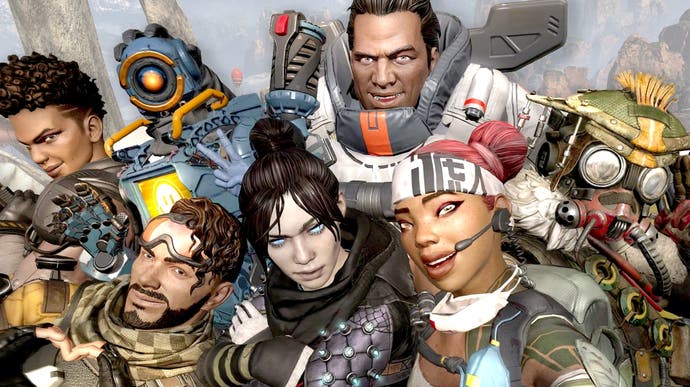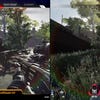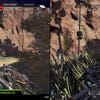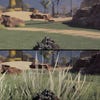Apex Legends on Switch: a fascinating port but are the cutbacks too severe?
And is CrossPlay actually fair?
Apex Legends' new Switch conversion may be one of the system's most ambitious to date - but the severity of the cutbacks is clearly an issue. Much has been said about the game's low resolution and the impact this has on visibility when targeting opponents at long range, but as our video head-to-head below reveals, the gulf in terms of visual features is tremendous, to the point where so many missing graphical elements may well have implications for the balance of the game when viewed through the lens of the CrossPlay feature.
In bringing Apex Legends to Switch, EA certainly chose a partner with pedigree - core porting work is carried out by Panic Button, riding high after the success of the excellent Switch conversion of Doom Eternal. But this is a title that represents a major challenge: it's a game with a huge, detailed map, it's a full-on battle royale with 60 players, and it's running on Respawn Entertainment's rendition of the Source Engine, never designed with mobile play in mind (though Source itself was ported to Android, with several Valve titles running on Shield Android TV using the same Tegra X1 chipset). The end result is perhaps inevitably, a highly pruned back experience - and it's one where the specific presentation of CrossPlay brings the compromises into the harshest of focus. Put simply, when we start a party with one player on Switch and the other on Xbox Series X, we can allow one player to die, switch to spectator mode and see entirely like-for-like imagery. The differences can be astonishing - far more so than, say, Fortnite, where the same CrossPlay trick reveals much closer level of parity.
It's worth pointing out at this stage that our tests are based on the 1.07 patch, which 'dropped' midway through production on this project - and it's understood to have some performance advantages, which is reflected in our analysis. Resolution has been flagged as an issue and it's certainly one of the challenges the game faces. We're looking at a maximum 720p in docked play, with dynamic resolution scaling dropping to 1066x600 minimum, which is something of a struggle to parse. Portable play is 576p dynamic, with a 960x540 minimum, and a corresponding drop in the quality of texture filtering when stacked up against the docked experience. But that's just the start of the feature culling compared to the Xbox Series X: textures lose an immense amount of detail, shadows are also affected, while draw distances are pulled in, obscured by fog (thankfully in a way that does not impact gameplay). Effects work is also pared back, with bandwidth-sapping transparency effects also running at a much lower fidelity. Trees and bushes are retained, but asset quality is lower here too. Incidental ground object detail is also massively reduced.
Perhaps the most contentious cut concerns grass and foliage, the vast majority of which is totally removed - typically a cut that developers are loath to make in multiplayer experiences as it fundamentally changes the 'readability' of any given scene. It also tends to be a locked setting on PC, stopping players from gaining an unfair advantage by turning off visual elements. On the one hand, it's clear that other players are far more easily exposed when viewed through the lens of the Switch which may be a problem. On the other, Apex Legends doesn't have a prone function - players hiding in the undergrowth isn't a core part of the experience. It comes across as a cut too far, but at the same time, with users on every other platform running at 60 frames per second up against the Switch's 30fps target, some might say that CrossPlay is stacked against users of the Nintendo hybrid straight out of the box. Similarly, Xbox, PlayStation and PC users can adjust field of view - this option isn't available on Switch.
What users effectively get is a good enough, albeit lower poly rendition of the game world. Everything is as it should be and renders properly at range. Think of it as a less complex but decent enough rendition of the world. Reflections are also retained, lens flares are kept, while cloth physics are present and correct. Enemies also render in at the same range, crucial to a fair experience for all players. Switch exclusive benefits are thin on the ground, but gyro aiming is included.
As for performance, things start out shakily as the initial jump sees frame-rates tumble into the low 20fps range - it's not crucial to the core of the experience, but as an initial 'handshake' with the game, it's not the best showing. The target 30 frames per second is largely maintained during traversal, with the initial scavenging phase of the classic battle royale formula usually running as it should, though inconsistent frame-pacing can sometimes intrude. The main problem is that frame-rate problems intrude during confrontations with other players - exactly where performance should be at its best. On top of that, there's the sense the frame-rate may start to buckle simply by being in proximity to other players - an unlikely early warning system of sorts?
Ultimately, this is Apex Legends and it does work but the compromises are often brutal. It's a free download, it is content complete with full season eight parity and I'd certainly recommend trying it out - you have nothing to lose, after all. However, CrossPlay is on by default and I can't help but think that the cutbacks to the experience are so severe that you may have more fun turning off the feature and playing with other Switch users exclusively, if only to level what is otherwise a highly uneven playing field.














.png?width=291&height=164&fit=crop&quality=80&format=jpg&auto=webp)


